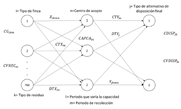Diseño de una red de logística inversa: caso de estudio Usochicamocha - Boyacá
Main Article Content
Keywords
Logística inversa, Linear programming, plaguicidas, retorno de envases, programación lineal, reciclaje, disposición segura de envases
Resumen
Este artículo presenta los resultados finales de una investigación adelantada en el distrito de riego Usochicamocha del Departamento de Boyacá - Colombia, el cual enfrenta un problema a causa de la no devolución y recolección de la totalidad de los envases y empaques vacíos de plaguicidas que generan los agricultores. Debido a lo anterior, con la investigación se propone una configuración y funcionamiento de la red de logística inversa (LI) para la recolección, acopio y disposición final de los residuos de plaguicidas en dicha zona, para lo cual se desarrolla un modelo de programación lineal entera mixta con el fin de definir tanto las cantidades a recolectar y transportar a disposición final y evaluar la posibilidad de abrir nuevos centros de acopio. Los resultados del modelo matemático evidencian que, en promedio, se recolectan en cada finca 5 kg de residuos y que se envían 1106.58 kg a eliminación segura y 1292.31 kg a reciclaje.
Descargas
Referencias
[2] A. Diabat, D. Kannan, M. Kaliyan, and D. Svetinovic, “An optimization model for product returns using genetic algorithms and artificial immune system,” Resources, conservation and recycling, vol. 74, pp. 156–169, 2013.
[3] M. Gallo, T. Murino, and E. Romano, “The simulation of hybrid logic in reverse logistics network,” Selected Topics in System Science and Simulation Engineering, pp. 378–384, 2010.
[4] D. S. Rogers and S. Ronald, “Going backwards: reverse logistics trends and practices,” 1999.
[5] M. J. Álvarez-Gil, P. Berrone, F. J. Husillos, and N. Lado, “Reverse logistics, stakeholders’influence, organizationalslack,and managers’posture,” Journal of business research, vol. 60, no. 5, pp. 463–473, 2007.
[6] J. R. Stock, Reverse logistics: White paper. Council of Logistics Management, 1992.
[7] D. S. Rogers and R. Tibben-Lembke, “An examination of reverse logistics practices,” Journal of business logistics, vol. 22, no. 2, pp. 129–148, 2001.
[8] M. Fleischmann, J. M. Bloemhof-Ruwaard,R. Dekker, E. Van der Laan, J. A. Van Nunen, and L. N. Van Wassenhove, “Quantitative models for reverse logistics: A review,” European journal of operational research, vol. 103, no. 1, pp. 1–17, 1997.
[9] C. R. Carter and L. M. Ellram, “Reverse logistics: a review of the literature and framework for future investigation,” Journal of business logistics, vol. 19, no. 1, p. 85, 1998.
[10] J. R. Stock and J. P. Mulki, “Product returns processing: an examination of practices of manufacturers, wholesalers/distributors, and retailers,” Journal of Business Logistics, vol. 30, no. 1, pp. 33–62, 2009.
[11] V. D. R. Guide Jr and L. N. Van Wassenhove, “Or forum—the evolution of closed-loop supply chain research,” Operations research, vol. 57, no. 1, pp. 10–18, 2009.
[12] T.-L. Hu, J.-B. Sheu, and K.-H. Huang, “A reverselogistics cost minimization model for the treatment of hazardous wastes,” Transportation Research Part E: Logistics and Transportation Review, vol. 38, no. 6, pp. 457–473, 2002.
[13] R. Verma, G. R. Plaschka,B. Hanlon, A. Livingston, and K. Kalcher,“Predicting customer choice in services using discrete choice analysis,” IBM Systems Journal, vol. 47, no. 1, pp. 179–191, 2008.
[14] C. Lee and T. Chan, “Development of rfid-based reverse logistics system,” Expert Systems with Applications, vol. 36, no. 5, pp. 9299–9307, 2009.
[15] M. Hosseinzadeh and E. Roghanian, “An optimization model for reverse logistics network under stochastic environment using genetic algorithm,” International Journal of Business and Social Science, vol. 3, no. 12, pp. 1–17, 2012.
[16] S. Elfvendahl, M. Mihale, M. A. Kishimba, and H. Kylin, “Pesticide pollution remains severe after cleanup of a stockpile of obsolete pesticides at vikuge, tanzania,” AMBIO: A Journal of the Human Environment, vol. 33, no. 8, pp. 503–508, 2004.
[17] A. Buczynska and I. Szadkowska-Stanczyk, “Identification of health hazards to rural population living near pesticide dump sites in poland,” International journal of occupational medicine and environmental health, vol. 18, no. 4, pp. 331–339, 2005.
[18] I. D. Haylamicheal and M. A. Dalvie, “Disposal of obsolete pesticides, the case of ethiopia,” Environment international, vol. 35, no. 3, pp. 667–673, 2009.
[19] W. J. Ladeira, A. E. Maehler, and L. F. M. d. Nascimento, “Logística reversa de defensivos agrícolas: fatores que influenciam na consciência ambiental de agricultores gaúchos e mineiros,” Revista de Economia e Sociologia Rural, vol. 50, no. 1, pp. 157–174, 2012.
[20] E. D. C. Castañeda, A. M. F. Benítez, and J. D. S. Rodríguez, “Diseño de un sistema de logística inversa para la recolección de envases y empaques vacíos de plaguicidas,” Revista Ingeniería Industrial, vol. 12, no. 2, 2013.
[21] R. K. Yin, Case study research: Design and methods. Sage publications, 2013.
[22] H. A. Taha, Investigación de operaciones. Pearson Educación, 2004.

